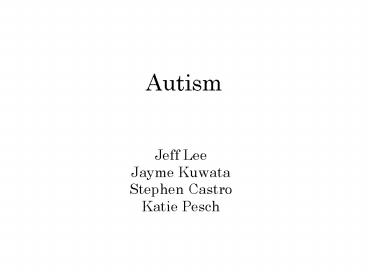Autism - PowerPoint PPT Presentation
1 / 17
Title:
Autism
Description:
... mannerisms (e.g hand or finger flapping or twisting, or complex ... Boys are four times likelier to have autism than girls. It is treatable but not curable ... – PowerPoint PPT presentation
Number of Views:39
Avg rating:3.0/5.0
Title: Autism
1
Autism
- Jeff Lee
- Jayme Kuwata
- Stephen Castro
- Katie Pesch
2
Definition (IDEA, 1997)
- A developmental disability significantly
affecting verbal and non-verbal communication and
social interaction, usually evident before age 3,
that adversely affects a childs educational
performance. Other characteristics often
associated with autism are engagement in
repetitive activities and stereotyped movement,
resistance to environmental change or change in
daily routines, and unusual sensory experiences.
3
DSM IV Diagnostic Criteria (1994)
- Criteria for Autism Disorder - 299.00
- A. A total of six (or more) items from (1), (2),
and (3), with at least two from (1), and one each
from (2) and (3). - (1) qualitative impairment in social interaction,
as manifested by at least two of the following - a) marked impairments in the use of multiple
nonverbal behaviors such as eye-to-eye gaze,
facial expression, body posture, and gestures to
regulate social interaction - b) failure to develop peer relationships
appropriate to developmental level - c) a lack of spontaneous seeking to share
enjoyment, interests, or achievements with other
people, (e.g., by a lack of showing, bringing, or
pointing out objects of interest to other people)
- d) lack of social or emotional reciprocity (
note in the description, it gives the following
as examples not actively participating in simple
social play or games, preferring solitary
activities, or involving others in activities
only as tools or "mechanical" aids )
4
DSM IV Diagnostic Criteria (1994) cont.
- (2) qualitative impairments in communication as
manifested by at least one of the following - a) delay in, or total lack of, the development of
spoken language (not accompanied by an attempt to
compensate through alternative modes of
communication such as gesture or mime) - b) in individuals with adequate speech, marked
impairment in the ability to initiate or sustain
a conversation with others - c) stereotyped and repetitive use of language or
idiosyncratic language - d) lack of varied, spontaneous make-believe play
or social imitative play appropriate to
developmental level
5
DSM IV Diagnostic Criteria (1994) cont.
- (3) restricted repetitive and stereotyped
patterns of behavior, interests and activities,
as manifested by at least two of the following - a) encompassing preoccupation with one or more
stereotyped and restricted patterns of interest
that is abnormal either in intensity or focus - b) apparently inflexible adherence to specific,
nonfunctional routines or rituals - c) stereotyped and repetitive motor mannerisms
(e.g hand or finger flapping or twisting, or
complex whole-body movements) - d) persistent preoccupation with parts of objects
- B. Delays or abnormal functioning in at least one
of the following areas, with onset prior to age 3
years - (1) social interaction
- (2) language as used in social communication
- (3) symbolic or imaginative play
- C. The disturbance is not better accounted for by
Rett's Disorder or Childhood Disintegrative
Disorder
6
Different Types of Pervasive Developmental
Disorders (PDD)
- Asperger Syndrome
- Childhood Disintegrative Disorder
- Retts Disorder
- Pervasive Developmental Disorder (not otherwise
specified PDD NOS) - Atypical Autisim
7
Types of Autism
- Low Functioning
- High Functioning
8
Video!!
- Starring Jeff and his Kids
9
History of Autism
- 1943 symptoms of autism were first identified by
Leo Kanner who worked out of Baltimore - Term autistic means to escape from reality
- used to term to describe an inability to relate
to themselves - Believed Autism were present at birth which was a
fundamental disturbance - Kanner believed that it could be described by two
main features - autistic aloneness
- obsessive insistence on sameness
- Hans Asperger in 1944 researched on autism also
- Bruno Bettelheim a psychoanalyst believed in the
refrigerator mothers theory
10
Causes
- There are no specific causes found yet.
- A neurological disorder
- Was believed to be the caused by the Thimerosal
vaccine, but this was proven wrong. - It was thought that Autism was the result of bad
child rearing practices.
11
Facts and Stats
- More that 500,000 people in the United States
have autism or a related developmental disorder - Most Common Pervasive Developmental Disorder
(PDD) - Autism affected 1 in 166 people
- Boys are four times likelier to have autism than
girls. - It is treatable but not curable
- Fastest growing developmental disability
- 90 of costs are in adult services
- Life long can be reduced by 2/3 with early
diagnosis and intervention
12
Observable Characteristics
- Inappropriate laughing or giggling
- No real fear of danger
- May not want cuddling
- Sustained unusual or repetitive play uneven
physical or verbal skills - May avoid eye-contact
- May prefer to be alone
- Difficulty in expressing needs may use gestures
- Inappropriate attachment to objects
- Insistence on sameness
- Echolalia (repeats words or phrases)
- Inappropriate or no response to sounds
- Spins objects or self
- Difficulty with social interactions
13
Types of Treatments
- Floor Time
- Behavioral Modification Techniques (ABA, DTT)
- Picture Exchange Communication (PECS)
- Social Stories
- Theory of Mind
14
Got Pamphlet?
- Time Filler
15
Activity Time!!
- Starring Katie and her funky game
16
Treatment Options in Hawaii
- The Institute for Family Enrichment (TIFFE)
- Child and Adolescent Resources for Education
(CARE) - Parent and Children Together (PACT)
- Loveland Academy
- Variety School
- Nurse Finders
- Hawaii Behavioral Health
- Child and Family Services
17
Fin!
- Thanks For Staying Awake and Attentive!!































